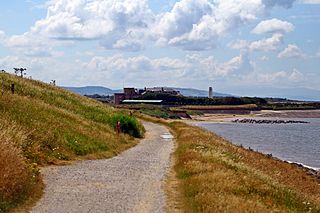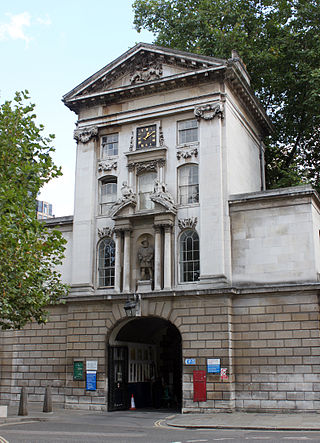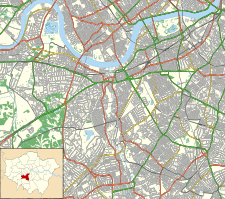
Leasowe is a village in the Metropolitan Borough of Wirral in Merseyside, England. Historically within Cheshire, Leasowe was part of the old County Borough of Wallasey. It is now within the Leasowe and Moreton East Ward of the Metropolitan Borough of Wirral, as well as the Wallasey parliamentary constituency.

The Liverpool Royal Infirmary was a hospital in Pembroke Place in Liverpool, England. The building is now used by the University of Liverpool.

St Bartholomew's Hospital, commonly known as Barts, is a teaching hospital located in the City of London. It was founded in 1123 and is currently run by Barts Health NHS Trust.

The Royal National Orthopaedic Hospital (RNOH) is a specialist orthopaedic hospital located in the London Borough of Harrow, United Kingdom, and a part of Royal National Orthopaedic Hospital NHS Trust. It provides the most comprehensive range of neuro-musculoskeletal health care in the UK, including acute spinal injury, complex bone tumour treatment, orthopaedic medicine and specialist rehabilitation for chronic back pain. The RNOH is a major teaching centre and around 20% of orthopaedic surgeons in the UK receive training there.

The Radcliffe Infirmary was a hospital in central north Oxford, England, located at the southern end of Woodstock Road on the western side, backing onto Walton Street.

The London Fever Hospital was a voluntary hospital financed from public donations in Liverpool Road in London. It was one of the first fever hospitals in the country.

Cromer and District Hospital opened in 1932 in the suburb of Suffield Park in the town of Cromer within the English county of Norfolk. The hospital is run by the Norfolk and Norwich University Hospitals NHS Foundation Trust and provides an important range of acute consultant and nurse-led services to the residents of the district of North Norfolk.
Dame Sarah Elizabeth Oram, became a senior member of the Army Nursing Service (ANS) and Queen Alexandra's Imperial Military Nursing Service (QAIMNS), and served as Principal Matron, Nursing Inspector in the QAIMNS, and was attached to the British Expeditionary Force, France, 1914–1915 and subsequently as Acting Matron-in-Chief, QAIMNS, Eastern Mediterranean Expeditionary Force, 1915–1919 during the First World War.

Dame Mary Rosalind Paget, DBE, ARRC, was a noted British nurse, midwife and reformer. She was the first superintendent, later inspector general, of the Queen's Jubilee Institute for District Nursing, which was renamed as the Queen's Institute of District Nursing in 1928 and as the Queen's Nursing Institute in 1973.

St Leonard's Hospital is a hospital in Hoxton, North London.

Epsom and Ewell Cottage Hospital is a small hospital in West Park Road, Horton Lane, Epsom, Surrey. It is managed by CSH Surrey.
Chailey Heritage School is a special school located in North Chailey, East Sussex, England. It is owned and operated by the Chailey Heritage Foundation. The school is for children and young adults, aged between 3 and 19, with complex physical disabilities and associated learning difficulties. The school has a sixth form. It is a charity. There is boarding accommodation on the site. NHS services are based at the same location.

The Metropolitan Free Hospital was a London hospital, founded in 1836 and based for most of its existence in Kingsland Road, Hackney. It became part of the NHS in 1948, and closed in 1977, with its residual functions transferring to Barts Hospital.

Richmond Royal Hospital, on Kew Foot Road in Richmond, London, England, is a mental health facility operated by South West London and St George's Mental Health NHS Trust, which has its headquarters at Springfield Hospital in Tooting. The hospital's original block is Grade II listed.

Hounslow Hospital was a small hospital for geriatric and long-stay patients situated in an industrial area of Hounslow, girdled by two motorways and Heathrow Airport. It was run by the Ealing, Hammersmith and Hounslow Area Health Authority.

The David Lewis Northern Hospital was located in Great Howard Street, Liverpool. It was first established in 1834 and closed in 1978.

Annie Sophia Jane McIntosh CBE, RRC was a British nurse and nursing leader. She was a Matron of St Bartholomew's Hospital, London (1910–1927), promoted the fledgling College of Nursing Ltd, and served on several wartime committees.
Bethnal Green Hospital was an acute care hospital, in Bethnal Green, close to Cambridge Heath in the London Borough of Tower Hamlets, England. It opened in 1900, and it closed in 1990.

Woburn Cottage Hospital was a hospital in Woburn, Bedfordshire, England.

















